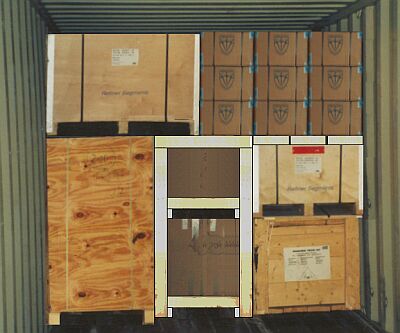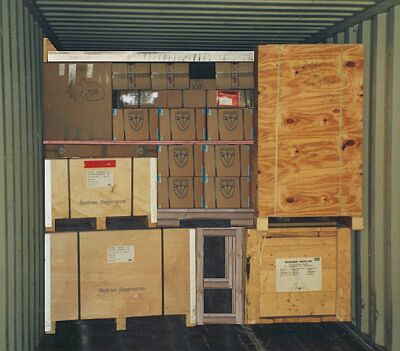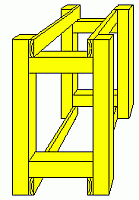 |
||
| Numbering of certain packages for error analysis | ||
Packages (2) and (3) may slip towards the container side wall (1). Package (4) may slip and tip and damage packages (5), (6) and (7) and other shipping packages. Repeated to-and-fro movements will damage not only the cargo but also the container itself. Even adjacent containers may be affected.
Packing errors become particularly clear if the container is tilted.
 |
Risks at 30° tilt |
Improvements may be achieved by a small amount of restowing and the use of squared lumber and boards, but the result is by no means optimal:
 |
||
| Reasonably usable result achieved by restowing and bracing | ||
With the method shown, the container wall is subjected to point-loading, as is the plywood case if it is not braced directly in the area of the front end wall. The latter measure results in plate action, so that no further damage would be likely to arise.
At any rate, boards or the like should be inserted at the side wall of the container for pressure distribution.
 |
||
| Possible variant of a well packed section | ||
Only with careful stowage planning can sensible packing and securing be achieved. It remains to be seen whether the suggestion given here is the best, but at least cargo damage should no longer occur. This Figure is merely intended to illustrate the possibility of a compact stow.
However, optimum stowage and securing can always be achieved by timely stowage planning. According to the CTU packing guidelines, there is an obligation to do this:
- 3.1.4 Packing should be planned before it is started. This should make it possible to segregate incompatible cargoes and produce either a tight or secured stow, in which the compatibility of all items of cargo and the nature, i.e. type and strength, of any packages or packaging involved are taken into account. The possibility of cross-contamination by odor or dust, as well as physical or chemical compatibility, should be considered.
Sometimes it is just little things which can turn an inadequately packed container into a satisfactorily packed container. This picture shows a well thought out solution:
 |
||
| Well packed and secured section | ||
Bracing has been inserted between the two cases in the bottom layer, the crosspieces of the bracing finishing flush with the floor and the top of the case. In this case, this is good, since the crosspieces introduce the forces satisfactorily into the lid areas. In the floor area, this is no longer ensured due to the different types of box.
It has been stated in the general section that the following arrangement of wooden members is the best for bracing, to ensure that the wooden members do not cave in at the face/end grain interface. This basic rule is particularly applicable to heavy cargoes.
 |
Bracing variant for heavy cargoes |
However, there are exceptions to every rule: In the packing example shown, it would have been appropriate to use a hybrid which was flush at the top but not at the bottom.
The squared lumber members used to brace the gap between the cases in the second layer have been deliberately raised, so that the forces are introduced into the case bottoms. To protect the cargo, plywood interlayer dunnage has been inserted between the cartons in the upper area of the section. The tipping forces from the large plywood case acting on the cartons were absorbed in the upper area by inserting squared lumber between this upper area and a wooden board placed against the container wall to distribute the pressure.